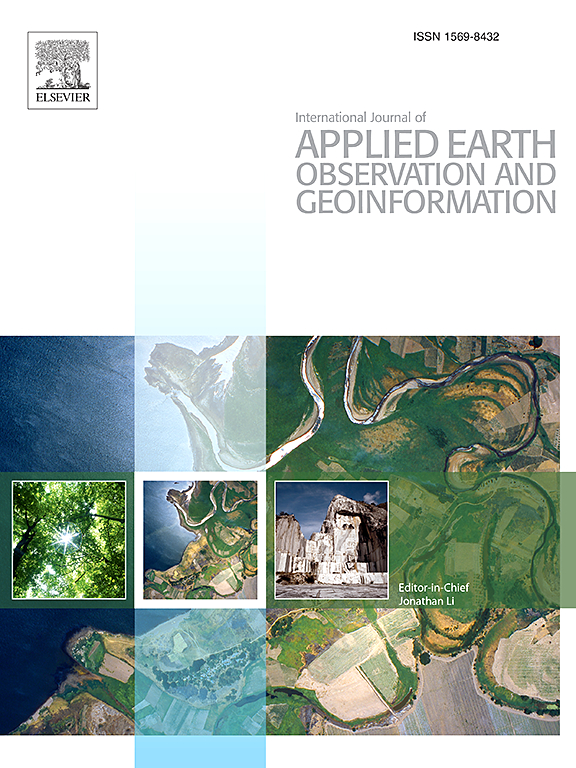Grace-based assessment of hydrometeorological droughts and their Possible teleconnection Mechanisms using wavelet based quantitative approach
IF 7.6
Q1 REMOTE SENSING
International journal of applied earth observation and geoinformation : ITC journal
Pub Date : 2025-02-16
DOI:10.1016/j.jag.2025.104410
引用次数: 0
Abstract
Climate change and recurrent extreme climatic events have intensified the vulnerability of water-stressed regions like Tunisia to droughts, severely impact agriculture, the economy, and society. This study analyzes hydro-meteorological drought patterns using the Gravity Recovery and Climate Experiment (GRACE) satellite-derived Groundwater Drought Index (GGDI), alongside traditional indices, including Standardized Precipitation Index (SPI), Standardized Precipitation-Evapotranspiration Index (SPEI), and Standardized Runoff Index (SRI). A stochastic analysis of monthly SPEI-GGDI values was conducted using a first-order Markov chain model, to investigate regional drought hazards formation, persistence, and evolution. Pearson’s correlation coefficient and wavelet coherence were applied to evaluate interactions among indices and their teleconnections with large-scale climate patterns. Results reveal persistent droughts, with extreme events exhibiting high stability and low recovery probabilities. The most severe groundwater drought occurred in 2014–2015, averaging a GGDI value of −1.36, while 2002–2003 was the driest based on SPEI, SPI, and SRI, averaging −1.9. Correlation analysis highlights complex interactions between meteorological and hydrological droughts, with GDDI-identified droughts exhibit greater severity in frequency, intensity, and duration, indicating significant anthropogenic influence. El Niño-Southern Oscillation (ENSO) significantly influenced drought evolution, with intense negative phases exacerbating severity. This study highlights the potential of GRACE satellite data for integrated drought monitoring and provides novel insights for developing sustainable drought management strategies in Tunisia.

求助全文
约1分钟内获得全文
求助全文
来源期刊

International journal of applied earth observation and geoinformation : ITC journal
Global and Planetary Change, Management, Monitoring, Policy and Law, Earth-Surface Processes, Computers in Earth Sciences
CiteScore
12.00
自引率
0.00%
发文量
0
审稿时长
77 days
期刊介绍:
The International Journal of Applied Earth Observation and Geoinformation publishes original papers that utilize earth observation data for natural resource and environmental inventory and management. These data primarily originate from remote sensing platforms, including satellites and aircraft, supplemented by surface and subsurface measurements. Addressing natural resources such as forests, agricultural land, soils, and water, as well as environmental concerns like biodiversity, land degradation, and hazards, the journal explores conceptual and data-driven approaches. It covers geoinformation themes like capturing, databasing, visualization, interpretation, data quality, and spatial uncertainty.
 求助内容:
求助内容: 应助结果提醒方式:
应助结果提醒方式:


